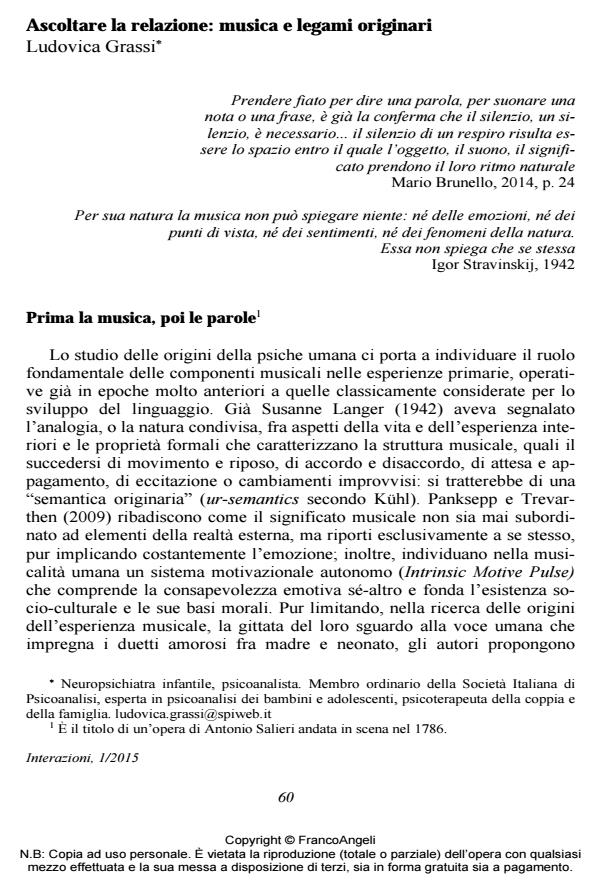Listening to the link. Music and primal relationships
Journal title INTERAZIONI
Author/s Ludovica Grassi
Publishing Year 2015 Issue 2015/1 Language Italian
Pages 15 P. 60-74 File size 73 KB
DOI 10.3280/INT2015-001006
DOI is like a bar code for intellectual property: to have more infomation
click here
Below, you can see the article first page
If you want to buy this article in PDF format, you can do it, following the instructions to buy download credits

FrancoAngeli is member of Publishers International Linking Association, Inc (PILA), a not-for-profit association which run the CrossRef service enabling links to and from online scholarly content.
Sharing the same fabric and dynamics with psychic life, music has a significant role in primal somato-psychic development and unfolding of representational processes: language itself springs out of musical innate competence and lies forever upon musical qualities. The analysis of a boy, whose existence begun in a condition of dislocation and dyschrony as to his parents’ desire, supports the hypotheses that when ruptures of the dawning sensory organization happen before the possibility itself of the existence of a mother-infant tie, they will affect the core of primal processes together with their rhythmical and sound features. It is suggested that in psychoanalytical research and clinic it is not a matter of applying psychoanalysis to music, but music to psychoanalysis.
Keywords: Dyschrony, music, primal processes, rhythm, silence, temporality
- Ammaniti M., Mazzoni S., Menozzi F. (2011). Cogenitorialità e gravidanza: studio ecografico. Interazioni, 2, 34: 49-56. DOI: 10.3280/INT2011-002005
- Aulagnier P. (1975). La violenza dell’interpretazione. Dal pittogramma all’enunciato. Roma: Borla, 1994.
- Anzieu D. (1979). The Sound Image of the Self. Int. R. Psycho-Anal., 6: 23-36.
- Bick E. (1964). Notes on Infant Observation in Psychoanalytic Training. Int. J. Psycho-Anal., 45: 558-566.
- Brandt P.A. (2009). Music and how we become human-a view from cognitive semiotics. Exploring imaginative hypotheses. In: Brandt P.A., Communicative musicality: exploring the basis of human companionship. Oxford: Oxford University Press.
- Brown S. (2000). The “Musilanguage” Model of Music Evolution. In: Wallin N.L.,Merker B., Brown S., The Origins of Music. Cambridge: MA, The MIT Press.
- Brunello M. (2014). Silenzio. Bologna: Il Mulino.
- Busoni F. (1907). Cenni di una nuova estetica musicale. Harmonia. Roma: ottobre 1913.
- Di Benedetto A. (2001). Prima della parola. L’ascolto psicoanalitico del non detto attraverso le forme dell’arte. Milano: Franco Angeli.
- Fraisse P. (1974). Psicologia del ritmo. Roma: Armando, 1979.
- Freud S. (1895). Progetto per una psicologia. OSF, vol. 2. Torino: Bollati Boringhieri.
- Freud S. (1938). Compendio di psicoanalisi. OSF, vol. 11. Torino: Bollati Boringhieri.
- Giuffrida A. (2014). Ciò che esiste allo scopo di non essere trovato. Psiche, 2: 319-
- 334. DOI: 10.7388/78144.GrassiL.(2013).Dimensionesonoraeritmicanellastrutturazionepsichicaenellavoroanalitico.RivistadiPsicoanalisi,1,59:11-32
- Green A. (1993). Il lavoro del negativo. Roma: Borla, 1996.
- Heidegger M. (1924). Il concetto di tempo. Milano: Adelphi, 1998.
- Kühl O. (2007). Musical semantics. European Semiotics: Language, Cognition and Culture, 7. Bern: Peter Lang.
- Langer S. (1942). Philosophy in a New Key. Cambridge MA: Harvard University Press.
- Laplanche J. (1999). Tra seduzione e ispirazione: l’uomo. Bari-Roma: La Biblioteca, 2002.
- Malloch S., Trevarthen C. (2009). Communicative musicality: exploring the basis of human companionship. Oxford: Oxford University Press.
- Meltzer D., Harris M. (1976). Il ruolo educativo della famiglia. Un modello psicoanalitico dei processi di apprendimento. Centro Scientifico Torinese, 1986.
- Ogden T.H. (2014). Fear of breakdown and the unlived life. International Journal of Psychoanalysis, 95: 205-223. DOI: 10.1111/1745-8315.12148
- Osborne N. (2009). Towards a chronobiology of musical rhythm. In: Malloch S., Trevarthen C., a cura di, Communicative musicality. Exploring the basis of human companionship. Oxford: Oxford University Press.
- Panksepp J., Trevarthen C. (2009). The neuroscience of emotion in music. In: Malloch S., Trevarthen C., a cura di, Communicative musicality: exploring the basis of human companionship. Oxford: Oxford University Press.
- Pigozzi L. (2008). A nuda voce. Vocalità, inconscio, sessualità. Torino: Antigone.
- Schumann R. (1834). La musica romantica, a cura di Ronga L. Torino: Einaudi, 1970.
- Serra C. (2012). Voce. In: Vizzardelli S., Cimatti F., Filosofia della psicoanalisi. Macerata: Quodlibet.
- Turner R., Ioannides A.A. (2009). Brain, music and musicality: inferences from neuroimaging. In: Malloch S., Trevarthen C., a cura di, Communicative musicality: exploring the basis of human companionship.Oxford: Oxford University Press.
- Vizzardelli S. (2012). Ripetizione. In: Vizzardelli S., Cimatti F., Filosofia della psicoanalisi. Macerata: Quodlibet.
- Winnicott D.W. (1967). La sede dell’esperienza culturale. In: Winnicott D.W. (1971), Gioco e realtà. Roma: Borla, 1974
- Winnicott D.W. (1974). Fear of breakdown. In: Winnicott C., Shepherd R., Davis M., editors, Psychoanalytical explorations. Cambridge, MA: Harvard UP, 1989.
Ludovica Grassi, Ascoltare la relazione: musica e legami originari in "INTERAZIONI" 1/2015, pp 60-74, DOI: 10.3280/INT2015-001006